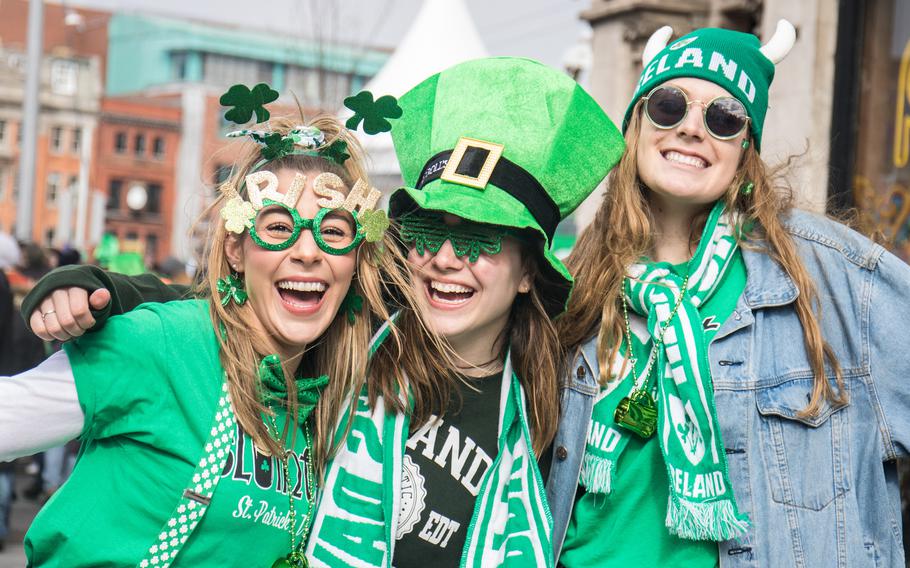
St. Patrick’s Day-related revelry will take place in several cities on Europe on March 17. (iStock)
The vernal equinox of the Northern Hemisphere occurs on March 20 in 2024, and with that, spring will have officially arrived in Europe. While equinoxes tend not to be celebrated with the same fervor reserved for their astrological cousins the solstices, the Continent offers a handful of places in which the changing of the seasons and celestial phenomena get their fair due.
St. Patrick’s Day
St. Patrick was a real-life figure born in Great Britain near the end of the fourth century. At the age of 16, Patrick was taken prisoner by a group of raiders who brought him to Ireland and held him in captivity for six years. Working in isolation as a shepherd, he turned to his religion for solace and dreamed of converting the Irish to his belief system. He is believed to have died on March 17, around 460 A.D.
According to the website irishcentral.com, some speculate that the close proximity of the spring equinox to St. Patrick’s Day could be due to a merging of ancient Celtic traditions with more modern Catholic rituals. As many pre-Christian beliefs and festivals were incorporated into the emerging religion of Christianity, it’s conceivable that a Spring Equinox festival was “rebranded” as a day to celebrate one of the world’s best-known saints.
Europe’s biggest celebration of St. Patrick takes place in Dublin, Ireland, where festivities stretch over several days. Much of the action will take place March 16-17 at the Festival Quarter at the National Museum of Ireland, Collins Barracks. The historical heritage site will be transformed into a lively urban festival hub consisting of a covered main stage, more intimate performance spaces, chill zones and an Irish Food and Craft Village. Daytime events are free of charge and while no tickets are necessary, entry is on a first-come, first serve basis. The city’s highlight event is a huge parade that sets forth at noon on March 17 and traces a route starting from Parnell Square, crossing O’Connell Bridge and ending at the Cuffe St./Kevin St. junction. Online: stpatricksfestival.ie
Other places in Ireland where St. Patrick’s Day is commemorated include Dingle, where a fife and drum parade of sets forth at the crack of dawn on March 17; late risers can enjoy the main parade from 12:45 p.m. Kilkenny and Cork are also home to sizable celebrations.
In London, a St. Patrick’s Day parade will set off from Hyde Park Corner sometime around noon on March 17 and pass through Piccadilly, St James’s Street, Pall Mall, Cockspur Street and Whitehall. The Irish-themed festivities taking place at Trafalgar Square include performances by dance troupes and community choirs, workshops for children and food demos. Activities take place from noon-5 p.m. Online: london.gov.uk/events/st-patricks-day-2024
Birmingham, England, home to a sizable Irish community, gets into the green with a parade that sets forth at noon on March 17 from the Camp Hill Island side of Bradford Street and winds up near the Digbeth Coach Station. At 12:45 p.m., a stop along the way will include a tribute to the late Shane MacGowan. All those gathered are invited to join in a rendition of The Pogues’ “Dirty Old Town.” The parade is followed by concerts by various Irish tribute bands, which are ticketed events. Online: tinyurl.com/233stmuf
Another home to a rocking good time on St. Patrick’s Day is Munich, Germany. On March 16-17, the city’s Odeon Square becomes a mini-Ireland of sorts, offering a stage for concerts and shows, food trucks serving Irish-inspired grub and the pouring of lots of beer. A St. Patrick’s Day mass and concert with Irish music is offered at St. Ludwig’s Church from 6 p.m. March 16. The traditional St. Patrick’s Day Parade starts off from Münchner Freiheit at noon on March 17. Online: stpatricksday.de/programm/1031
Geographical alignments
A handful of ancient monuments scattered across the planet function as astronomical calendars. Each year at the time of the Spring Equinox, Stonehenge in Wiltshire, England, attracts an eclectic mix of neo-druids, neo-pagans, Wiccans, traditional families and curious tourists. They come to observe the second of four sky points in the Wheel of the Year, a time when the sun rises exactly in the east, travels through the sky for 12 hours and then sets exactly in the west. A company by the name of Stonehenge Tours works closely with English Heritage to offer provide exclusive access tours during equinoxes and solstices, allowing their clients to be among the stones before the site opens to the general public. The company offers departures from both Bath and London. Online: stonehenge-tour.com
At the Loughcrew Megalithic Center in County Meath, Ireland, the back stone of Cairn T is lit up by the morning sunlight as is passes through a passageway. Repeated observations have shown that the complex engravings of the back stone are actually markers used to calibrate the day of the equinox. The natural phenomenon takes place over the three days closest to the time of equal days and nights, assuming, of course, there’s sunshine on the day. Online: loughcrewmegalithiccentre.com
Tucked into a hollow among the cliffs on the southern coast of the island nation of Malta, Mnajdra is a complex site consisting of three temples overlooking an oval forecourt. The Lower Temple has a particular astronomical alignment that allows the rays of the sun to pass through specific areas of the temple at the times of the Equinoxes, which fall on or around the dates of March 20 and Sept. 22 each year. Online: visitmalta.com/en/a/info/mnajdratemples